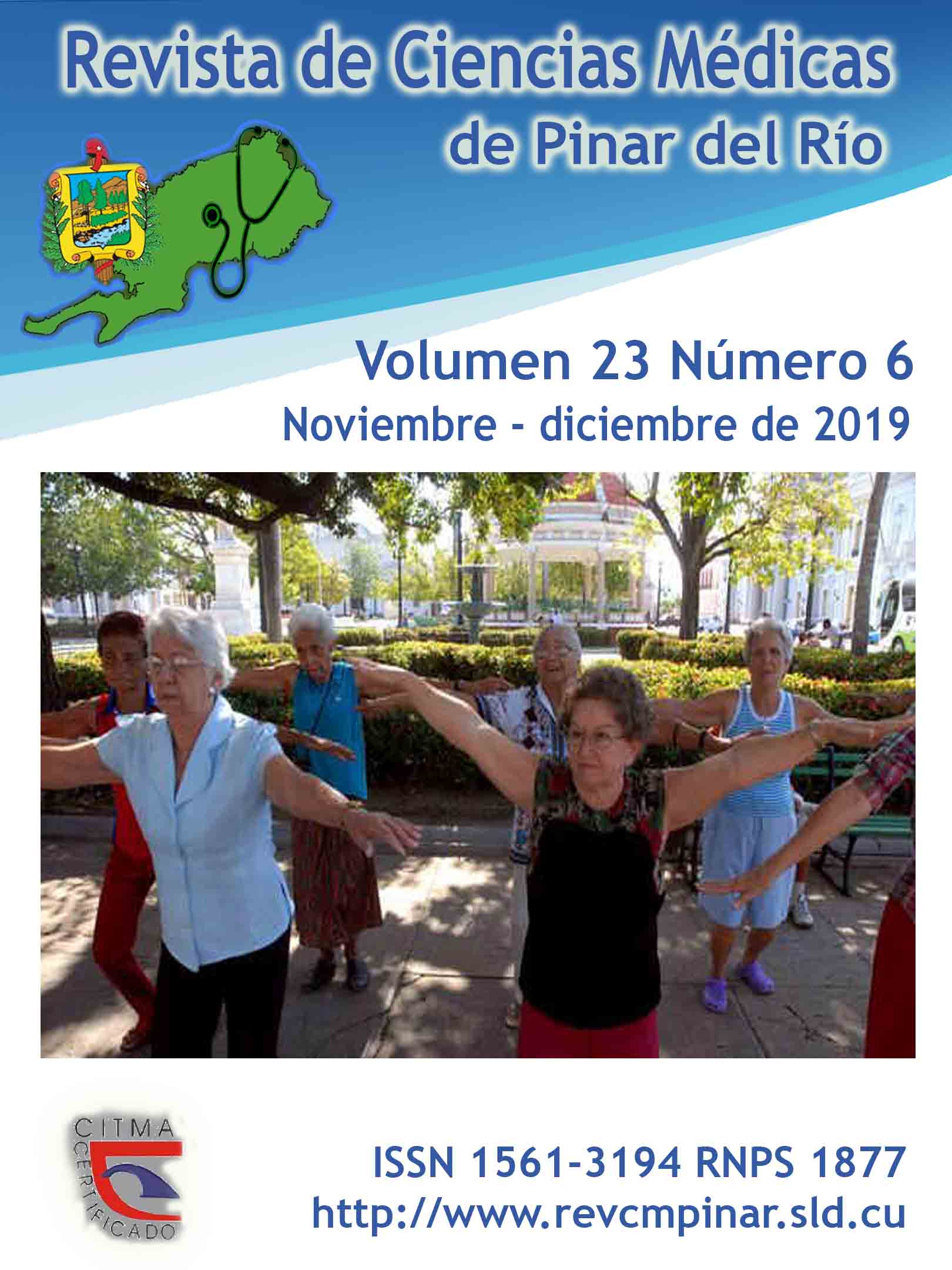Preconception reproductive risk behavior in fertile women from San Juan and Martinez municipality
Keywords:
PREGNANCY, HYPERTENSION, FAMILY PLANNING, RISK FACTORS, BIRTH RATE, TOBACCO USE DISORDER, VULVOVAGINITIS.Abstract
Introduction: birth control has been a constant concern since the dawn of humankind. Preconception risk control and management is of crucial importance, it is conditioned by a series of factors, diseases, unique or associated circumstances that may adversely affect the mother-child binomial during gestation, childbirth or puerperium.
Objective: to characterize preconception reproductive risk factors women of childbearing ages, belonging to the medical offices No- 26 and No-46 of San Juan and Martinez municipality in 2016.
Methods: an observational, descriptive and longitudinal study was carried out, the target group comprised 117 women of childbearing ages from the chosen clinics and the sample included 53 women who met the inclusion criteria. Data were summarized in absolute and relative frequencies.
Results: there was predominance of the age group between 30 and 39 years old, in the majority of them hypertension was found as an associated chronic disease, as gynecological conditions the most representative were vulvovaginitis, and as obstetric risk factor, shorter intergenesis period predominated. Mild preeclampsia prevailed as a complication of previous pregnancy and smoking was the most common toxic habit.
Conclusions: preconception reproductive risk was characterized in women of childbearing age; therefore it contributes to greater awareness and follow-up in family planning clinics.
Downloads
References
1. Arrate Negret MM, Linares Despaigne MJ, Molina Hechavarría V, Sánchez Imbert N, Arias Carbonel MM. Efectos secundarios de los anticonceptivos hormonales en usuarias del método asistentes a las consultas de planificación familiar. Rev Medisan. [Internet] 2013 [Citado 28/04/2017]; 17(3): [aprox. 15 p.]. Disponible en: http://scielo.sld.cu/scielo.php?script=sci_arttext&pid=S1029-30192013000300001
2. Chagimes Batista Y, Hernández Fernández A, Sánchez Álvarez de la Campa AI, Marín González MC, Rivera Alonso D. Comportamiento del riesgo preconcepcional genético. Rev Ciencias Médicas Pinar del Río. [Internet] 2013 [Citado 28/04/2017]; 17(4): [aprox. 9p.]. Disponible en: http://scielo.sld.cu/scielo.php?script=sci_arttext&pid=S1561-31942013000400007
3. Fawed Reyes O, Erazo Coello A, Carrasco Medrano JC, Mendoza Talavera AF, Mejía Rodríguez ME, et al. Complicaciones Obstétricas en Adolescentes y Mujeres Adultas con o sin Factores de Riesgo Asociados. Archivos de Medicina [Internet]. 2016. [Citado 28/04/2017]; 12(4): [aprox. 7p.]. Disponible en: https://pdfs.semanticscholar.org/da54/d3817a2e812060993ce0d9cf687053233599.pdf?_ga=2.265873231.1567010875.1570611609-2635063.1535783772
4 Estrada Nelson M, Agueida Carbonell AS, Galván Noa T. Epidemiología del riesgo reproductivo preconcepcional de causa genética. Rev Mediciego. [Internet] 2011 [Citado 28/04/2017]; 17(2): [aprox. 6p.]. Disponible en: http://bvs.sld.cu/revistas/mciego/vol17_02_2011/articulos/t-13.html
5. Fernández Borbón H, Gerez Mena S, Ramírez Pérez N, Pineda Bouzón A. Caracterización de la terminación voluntaria del embarazo en adolescentes. Rev Cubana Obstetricia y Ginecología. [Internet] 2014 [Citado 28/04/2017]; 40(2): [aprox. 8 p.]. Disponible en: http://scielo.sld.cu/scielo.php?script=sci_arttext&pid=S0138-600X2014000200007
6. Lau López S, Rodríguez Cabrera CA, Pría Barros MC. Problemas de salud en gestantes y su importancia para la atención al riesgo reproductivo preconcepcional. Rev Cubana de Salud Pública. [Internet] 2013 [Citado 28/04/2017]; 39(supl1): [aprox. 7 p.]. Disponible en: http://scielo.sld.cu/scielo.php?script=sci_arttext&pid=S0864-34662013000500004
7. Mombiela Guillén A, López Valls L, Marín Calduch M, Arasa Subero MM, Cardona Espuny C. Atención preconcepcional: prevención primaria. Rev Investigación en Mujer, Salud y Sociedad. [Internet] 2016 [Citado 28/04/2017]; 1(1): [aprox. 5p.]. Disponible en: http://revistes.ub.edu/index.php/MUSAS/article/download/vol1.num1.6/18491
8. González Portales A, Rodríguez Cabrera A, Jiménez González M. Caracterización de mujeres con riesgo preconcepcional en un consultorio médico. Rev Cubana Medicina General Integral. [Internet] 2016 [Citado 28/04/2017]; 32(2): [aprox. 10p.]. Disponible en:http://scielo.sld.cu/scielo.php?script=sci_arttext&pid=S0864-21252016000200005
9. Agénor M, Krieger N, Austin SB, Haneuse S, Gottlieb BR. Sexual Orientation Disparities in Papanicolaou Test Use among US Women: the Role of Sexual and Reproductive Health Services. Rev American Journal of Public Health. [Internet] 2014 [Citado 28/04/2017]; 104(2): [aprox. 10p.]. Disponible en: https://www.ncbi.nlm.nih.gov/pmc/articles/PMC3935675/
10. López Urbina GY. Morbimortalidad neonatal y su relación con los factores desencadenantes de partos prematuros en el servicio de sala de partos del Hospital Provincial Docente Ambato, Provincia de Tungurahuaen. [Internet]. Universidad Técnica de Ambato; 2015. [Citado 28/04/2017]. Disponible en: http://repo.uta.edu.ec/bitstream/123456789/9484/1/L%c3%93PEZ%20URBINA%20GLENDA%20YOMAIRA.pdf
11. Álvarez Sintes R. Temas de Medicina General Integral. 2 ed. v-1. La Habana: Editorial Ciencias Médicas; 2014. p.514.
12. Haro Salas MG, González Reyes Y. Mujeres con riesgo preconcepcional atendidas en el Hospital regional Docente Ambatato. Tesis previa a la obtención del título de médico cirujano [Internet]. Facultad de Ciencias Médicas de Ambato; 2016. [Citado 28/04/2017]. Disponible en: http://dspace.uniandes.edu.ec/bitstream/123456789/3504/1/TUAMED005-2016.pdf
13. Ortiz EI, Vásquez GA, Arturo MC, Medina VP. Protocolo de atención Preconcepcional. [Internet]. Universidad de Bogotá; 2014. [Citado 28 Abril 2017]. Disponible en: https://www.minsalud.gov.co/sites/rid/Lists/BibliotecaDigital/RIDE/VS/PP/SM-Protocolo-atencion-preconcepcional.pdf
Published
How to Cite
Issue
Section
License
Authors who have publications with this journal agree to the following terms: Authors will retain their copyrights and grant the journal the right of first publication of their work, which will be publication of their work, which will be simultaneously subject to the Creative Commons Attribution License (CC-BY-NC 4.0) that allows third parties to share the work as long as its author and first publication in this journal are indicated.
Authors may adopt other non-exclusive license agreements for distribution of the published version of the work (e.g.: deposit it in an institutional telematic archive or publish it in a volume). Likewise, and according to the recommendations of the Medical Sciences Editorial (ECIMED), authors must declare in each article their contribution according to the CRediT taxonomy (contributor roles). This taxonomy includes 14 roles, which can be used to represent the tasks typically performed by contributors in scientific academic production. It should be consulted in monograph) whenever initial publication in this journal is indicated. Authors are allowed and encouraged to disseminate their work through the Internet (e.g., in institutional telematic archives or on their web page) before and during the submission process, which may produce interesting exchanges and increase citations of the published work. (See The effect of open access). https://casrai.org/credit/



